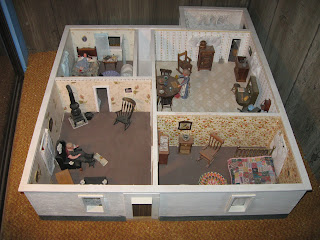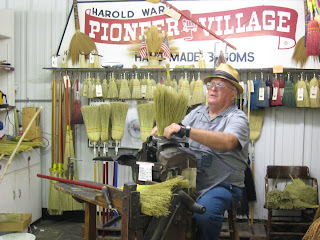
Sand dunes, we thought, were only in the deserts or by the sea side (shores). No, we’ve seen them inland in several States, the most beautiful so far being the Coral Pink sand dunes in Utah, (photo) but there were a few we passed on the roadside in Texas, more in Nevada and amazingly as far north as Colorado and Washington. Driving north, clumps of low pink flowers lined many of the verges and here and there were isolated wind mills pumping water for the small waterholes for cattle.
Habitation was few and far between and seemingly, the only presentable looking building in the small town of Nara Visa, NM was a Post Office; most of the small homes dotted along the highway were otherwise in a state of dereliction.
What amazed us most were the ginormous stockyards stretching for miles along the highway, or so we thought, but they were actually cattle feed lots. We learned this from the ranch owner of the “Western Star” campground who told us that the cattle are trucked there to be fattened up for three months before slaughtering. They receive a special mix of feed and live in practically all mud enclosures during that time - it made me almost want to become a vegetarian, almost.

We do see sheep but rarely is lamb offered in restaurants and not much in grocery stores either. So along Route 54, we rolled by huge grain silos and fields of crops, alfalfa mostly in the south but mainly thousands upon thousands of acres of field corn for the cattle stretching for miles on end and irrigated by long sprinkler systems. Nearly every home has grain silos on the grounds.
It’s a funny thing, but Kansas is truly the one State where we’ve experienced the worst weather. This particular campground in Liberal was fairly new and situated about 5 miles away and high above the town. There were no trees to block the wind and that evening with gusts reaching 45 mph and catching us broadside, our camper shook so severely that we thought about leaving for the safety of the nearest building. Shortly afterwards, the winds calmed down and we stayed. No wonder it’s so well known for tornados and the famous “Wizard of Oz”.
Dorothy’s House Museum from “The Wizard of Oz”
Dorothy’s House is one of the main attractions in Liberal and delights both children and adults alike. The young girl who presented the tour was dressed in the blue gingham pinafore with red shoes, just like Dorothy Gale in the movie. The actual home on this site was a 1907 farmhouse that was furnished and restored to represent, as faithfully as possible, the one in the film, made so many years ago in 1939.


Outside the house the yellow bricks we walked upon had been “bought” to help provide profits and were named and dated for the donors although the price of one was way beyond our means. Inside the huge barn, we followed another yellow brick road to find appealing displays, especially for children, of the three main characters along with talking Munchkins, Glenda, the Good Witch and a frightening, cackling bad witch set amongst vast amounts of colorful plastic flowers and trees.


The tiny museum holds the original model of the house (photo) that was used in the film as well as memorabilia from the Munchkin actors of that time. After our visit, I very much wanted to see the film again.

The town also celebrates an Ozfest during October, which, we read, has been attended in the past by various actors who played the Munchkins in the film, as well as the great -grandson of Frank L. Baum, who wrote the book “The Wonderful Wizard of Oz”.
Shrove Tuesday in Liberal, Kansas
Pancakes are the connection between Liberal and Olney, Buckinghamshire, in England, the home of the traditional annual Pancake race. It’s origin appears to have begun in 1445. The festival here begins several days before the races and now lasts four days with the International competition held on Tuesday and ends with a parade in the afternoon. The main street is even named Pancake Boulevard. The two towns have a special 60 year ongoing friendship.
The people we met in Kansas and overall in the mid western States seem to be naturally friendly towards strangers and, sitting at the “Cattleman’s Cafe” waiting to order, we were asked whether we’d like to hear a joke from a man at the table next to us. Without waiting for a reply, he told us a joke that he thought was very funny!
For a town the size of Liberal, with an estimated population now of around 20,368, it has a lot going for it, about 5 banks, 18 assortments of motels or Inns, several restaurants, one called “The Salty Dog”, an arts center, pheasant hunting on many public and private acres, the “Mid America Air Museum”, several festivals and fairs throughout the year and not forgetting 8 churches.
In even the smallest towns in America there are often more churches than you’d ever find in a small English town. That’s not unusual in this country where, it seems, that anyone who becomes a pastor can set up his/her own church and call it whatever they want. However, it also seems that many more people in America attend church services both on Sundays and mid-week, judging by the number of cars we see as we pass by.
 We were astonished by the thousands of articles displayed from about the 1830’s to the 1980’s. The second day is free of charge, and we needed two days to see it.
We were astonished by the thousands of articles displayed from about the 1830’s to the 1980’s. The second day is free of charge, and we needed two days to see it.  One of these was the General Store, stocked with some items we recognized from years ago, old butter churns, tins with familiar labels like Calumet Baking Soda, old cash registers, antique scales and a multitude of other items like animal traps and bushel baskets for fruit or corn. Hanging from the ceiling were numerous lanterns, buckets, an old cranberry picker and other various odds and sods. In the center was the most important item, the pot bellied stove, the only source for heating and keeping the coffee pot warm.
One of these was the General Store, stocked with some items we recognized from years ago, old butter churns, tins with familiar labels like Calumet Baking Soda, old cash registers, antique scales and a multitude of other items like animal traps and bushel baskets for fruit or corn. Hanging from the ceiling were numerous lanterns, buckets, an old cranberry picker and other various odds and sods. In the center was the most important item, the pot bellied stove, the only source for heating and keeping the coffee pot warm.
 We stepped inside one of the last Pony Express relay stations - a small cabin containing Buffalo Bill’s genuine, beautifully carved leather saddle. The photo shows a hand-made replica of the “mochila,” a leather cover for the saddle with four padlocked pockets for the mail at each corner, “which was left loose so it could be lifted off quickly and thrown on the saddle of a fresh horse that stood ‘rarin to go’”.
We stepped inside one of the last Pony Express relay stations - a small cabin containing Buffalo Bill’s genuine, beautifully carved leather saddle. The photo shows a hand-made replica of the “mochila,” a leather cover for the saddle with four padlocked pockets for the mail at each corner, “which was left loose so it could be lifted off quickly and thrown on the saddle of a fresh horse that stood ‘rarin to go’”.




























